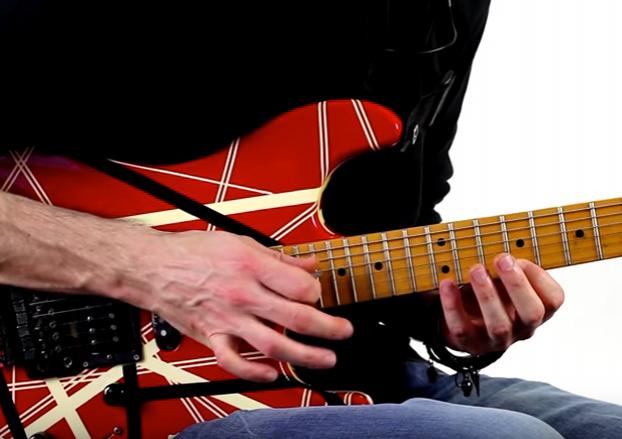A Brief History of Tapping—Plus a Tasty Natural Harmonics Lick

Tapping is one of the coolest, most impressive-sounding techniques in guitar playing. Not surprisingly, it’s also one of the most difficult and least understood.
Tapping, unlike other styles, uses the fingertip (or fingertips) of the "picking" hand to set a fretted string into vibration. This is different from the standard technique of fretting a string with the left hand and picking with the right (or the reverse if you’re a southpaw or a Jimi Hendrix imitator). Tapping, in effect, is a hammer-on/pull-off executed with the right hand tapping the high note in a passage, then releasing the string, allowing the note held by the left hand on the neck to ring out.
Who invented tapping? The history is unclear, but we do know the original shred master himself, Niccolo Paganini, used a similar technique by striking specific notes on the neck of his violin with his bow. One hundred and fifty years later, Steve Vai employed the tapping technique as we know it to play his famous interpretation of a Paganini lick on guitar.
And while Steve, unlike Paganini, is not rumored to have sold his soul to the Devil to gain his virtuosity, he did play the Dark Lord’s guitarist in that famous guitar duel between him and Ralph Macchio in the 1986 film Crossroads.
According to Vai, the hardest part of his role was acting like he couldn’t play the Paganini lick he had transposed. Funny, I would’ve thought it was losing a rock-off to the Karate Kid. But I digress…
After Paganini, tapping resurfaced as a technique used by early 20th-century guitarists including jazz virtuoso Tal Farlow, but it wasn’t until the 1960s that it made its way into the rock pantheon. Here the credit goes to Harvey Mandel. That’s right, the guitar player for Canned Heat. Oh, you don’t know who that is? Remember that song “On the Road Again”?” Think back—it had a high pitched vocal, blues chugging beat and tambura Eastern-sounding resonance, and it’s been featured on the soundtracks of Forrest Gump, The Blind Side and just about every Vietnam War movie there is.
Still don’t know? Go ask your parents, or—better yet—that uncle who went to Woodstock. He probably has one of their albums on eight-track. According to George Lynch, guitarist for Dokken and later Lynch Mob (not to mention a tapping expert) he witnessed Mandel employing a tapping technique at a Canned Heat show at the Starwood, a popular West Hollywood club, in the Seventies. Lynch wasn't alone that night. He was accompanied by a friend and fellow guitarist who would go on to redefine tapping and bring the technique to the mainstream. His name was Edward Van Halen.
In 1977, Van Halen dropped their debut album. And with it came the instrumental masterpiece “Eruption,” which featured a tapping section the likes of which the world had never heard. Most of “Eruption’s” tapping comes in the form of triplets—that’s three notes played in the same rhythm together. In Edward’s case, they were played very fast. He used his right-hand index or middle finger to tap strongly on the top note, then flick to the side (making the note ring louder). From there, his left-hand fingers would pull-off and hammer on the corresponding notes further down the neck. This created a cascade of notes—a trill, if you will—that suddenly had every rock guitarist on the planet struggling to learn this two-handed technique. And rock leads have never been the same.
But Edward had another tapping technique up his sleeve that seldom gets the attention it deserves: harmonics. This is what you hear in such songs as “Women in Love” and “Dance the Night Away.” Tapped harmonics—done right—can have a beautiful keyboard-like sound. The technique is relatively simple: Hold a note with your left hand and tap the same note an octave up the neck. In other words, if you’re holding the B note (seventh fret) on the first (high E) string, you'd tap the B note (19th fret) on the same string.
But, and here’s what produces that wonderful harmonic sound as opposed to a note, you must tap on the fret itself. In ordinary tapping, you’ll be aiming for the note on the neck between the frets. With natural harmonics, you will be striking the fret itself. I used this technique on the intro and first chorus of Stone Mob’s anthem about youth, “Young Punks.” Listen to “Young Punkz” (bottom video), then check out the instructional video above it. Not only will you learn this tasty lick, but you’ll add the technique of natural harmonic tapping to your arsenal of shred.
Cheers—and keep those fingers tapping!
Get The Pick Newsletter
All the latest guitar news, interviews, lessons, reviews, deals and more, direct to your inbox!









![Joe Bonamassa [left] wears a deep blue suit and polka-dotted shirt and plays his green refin Strat; the late Irish blues legend Rory Gallagher [right] screams and inflicts some punishment on his heavily worn number one Stratocaster.](https://cdn.mos.cms.futurecdn.net/cw28h7UBcTVfTLs7p7eiLe.jpg)
